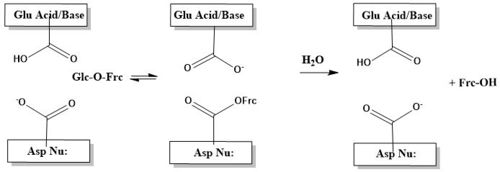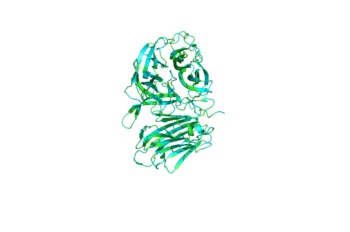Davis L. Martinec/Sandbox 4eqv
From Proteopedia
(Difference between revisions)
| Line 28: | Line 28: | ||
=== Open & Closed Assembly === | === Open & Closed Assembly === | ||
| - | The β-sandwich domain section touches on the topic of dimerization and tetramerization, and that will be explored here further. SInv is an octamer, though is better described as a tetramer of dimers. The dimers can be further categorized into | + | The β-sandwich domain section touches on the topic of dimerization and tetramerization, and that will be explored here further. SInv is an octamer, though is better described as a tetramer of dimers. The dimers can be further categorized into open(chains E, F, G, H) and closed assemblies(chains A, B, C, D) . The difference in assembly type - open versus closed - has implications involving substrate scope. The closed assembly is borne out of many polar interactions and large surface area of interactions between the β-sandwich domain of one chain and catalytic pocket(β-propeller domain) of the corresponding chain<ref>DOI: 10.1016/j.jmb.2007.05.022</ref>. Compared with the open assembly, the closed assembly has a interaction surface twice as large as the open assembly<ref name="fructo" />. This strong interaction between monomers, makes the catalytic pocket highly specific for sucrose<ref name="fructo" />. The images below illustrate difference between the monomers that make up 4EQV. The upper left image shows the alignment of chains B and F, upper right shows the alignment of chains A and E. The differences highlighted here are responsible for the open vs. closed assemblies. The lower left image shows the alignment of chains E and F, lower right shows the alignment of chains A and B. |
<div style="display: inline; width: 700px; float: right;"> | <div style="display: inline; width: 700px; float: right;"> | ||
[[Image:Chain_B-F_alignment_ray_trace.png|350 px]][[Image:Chain_A-E_alignment_ray_trace.png|350 px]] </div> | [[Image:Chain_B-F_alignment_ray_trace.png|350 px]][[Image:Chain_A-E_alignment_ray_trace.png|350 px]] </div> | ||
| - | |||
| - | |||
| - | test test test testtest test test testtest test test testtest test test testtest test test testtest test test testtest test test testtest test test testtest test test testtest test test testtest test test testtest test test testtest test test testtest test test testtest test test testtest test test testtest test test testtest test test testtest test test testtest test test testtest test test testtest test test testtest test test test | ||
| - | |||
<div style="display: inline; width: 700px; float: right;"> | <div style="display: inline; width: 700px; float: right;"> | ||
[[Image:Chain_E-F_alignment_ray_trace.png|350 px]][[Image:Chain_A-B_alignment_ray_trace.png|350 px]] </div> | [[Image:Chain_E-F_alignment_ray_trace.png|350 px]][[Image:Chain_A-B_alignment_ray_trace.png|350 px]] </div> | ||
| - | + | Though it might seem like a deficiency that only four of the eight catalytic sites are highly specific for sucrose or oligosaccharide with more than 4 units , this is actually allows 4EQV to much more versatile. The open assemblies(chains E, F, G, H), are capable of accommodate larger substrates such as ketoses or extended fructans. This can explain yeast's ability to to utilize the varied sugars found in its environment, and ulimately, the metabolic success of yeast<ref name="3d" />. | |
| - | + | ||
| - | + | ||
| - | + | ||
| - | the < | + | |
| - | + | ||
---- | ---- | ||
Revision as of 15:09, 27 April 2020
4EQV - Saccharomyces Invertase
| |||||||||||





